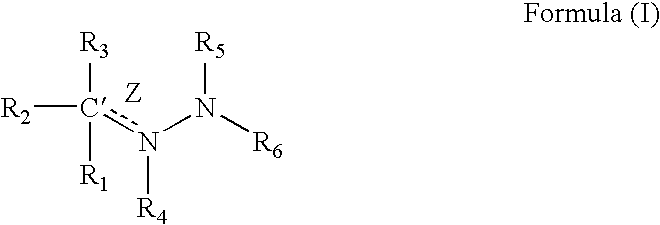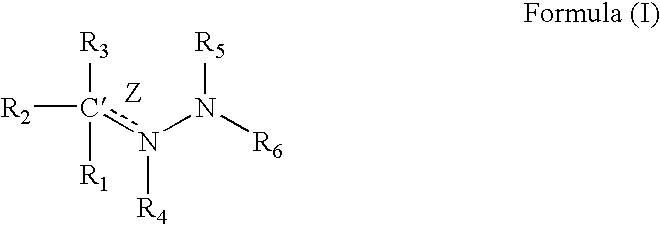Medicinal uses of hydrazones
a technology of hydrazone and hydrazone, which is applied in the direction of biocide, drug composition, cardiovascular disorder, etc., can solve the problems of lack of oxygen supply, tissue damage, health problems affecting hundreds of millions of people, etc., and achieve the effects of increasing vascularization of tissue, increasing epo, and safe and effective amoun
- Summary
- Abstract
- Description
- Claims
- Application Information
AI Technical Summary
Benefits of technology
Problems solved by technology
Method used
Image
Examples
examples 1-32
The following chart shows the structure of compounds made according to the procedures described in Examples 1-32.
.sup.1 EC.sub.50 is the concentration of compound that induces the production of an amount of VEGF equal to half the maximum amount of VEGF induced by that compound.
Compounds are analyzed using .sup.1 H and .sup.13 C NMR obtained on a Varian Unity plus 300 MHz spectrometer, chemical shifts are reported in .delta. ppm downfield from TMS as an internal standard. The compounds are also analyzed using elemental analysis, mass spectra using a Fisons Platform-II quadrupole mass spectrometer, high resolution mass spectra and / or IR spectra as appropriate. Thin layer chromatography (hereinafter "TLC") analysis is performed on glass mounted silica gel plates (200-300 mesh; Baker or Analtech) with fluorescent indicator and visualized using UV detection.
example 1
N-Pyridin-2-yl-N'-2-ylmethylene-hydrazine (1c): ##STR10##
To a solution of 2-pyridinecarboxaldehyde 1a (10 mmol, 1 equiv.) in ethanol (20 mL) is added 2-hydrazinopyridine 1b (10 mmol, 1equiv.) to form a 0.5 M solution. The mixture is heated at reflux (60.degree. C.) for 6 hours or until the TLC (66% ethyl acetate / hexanes) shows disappearance of starting material. Upon forming or cooling, the desired product N-pyridin-2-yl-N'-2-ylmethylene-hydrazine 1c, precipitates and is filtered and washed with diethylether. The pale yellow solid is dried under vacuum for 15 hours. Generally, only the first crop is collected, characterized and tested.
Utililizing substantially the method of Example 1 and appropriate hydrazine, aldehyde, or ketone, the following subject compounds of Examples 2-108 are obtained. Modifications are described below.
example 2
N-Pyridin-2-yl-N'-(1-pyridin-2-yl-ethylidene)hydrazine: ##STR11##
In a procedure analogous to Example 1,2-acetylpyridine is combined with 2-hydrazinopyridine to form N-Pyridin-2-yl-N'-(1-pyridin-2-yl-ethylidene)hydrazine. N-Pyridin-2-yl-N'-(1-pyridin-2-yl-ethylidene)hydrazine is precipitated out of ethanol with water. The solid is filtered and dried to afford the product as a dihydrate.
PUM
| Property | Measurement | Unit |
|---|---|---|
| temperature | aaaaa | aaaaa |
| temperature | aaaaa | aaaaa |
| temperature | aaaaa | aaaaa |
Abstract
Description
Claims
Application Information
 Login to View More
Login to View More - R&D
- Intellectual Property
- Life Sciences
- Materials
- Tech Scout
- Unparalleled Data Quality
- Higher Quality Content
- 60% Fewer Hallucinations
Browse by: Latest US Patents, China's latest patents, Technical Efficacy Thesaurus, Application Domain, Technology Topic, Popular Technical Reports.
© 2025 PatSnap. All rights reserved.Legal|Privacy policy|Modern Slavery Act Transparency Statement|Sitemap|About US| Contact US: help@patsnap.com



